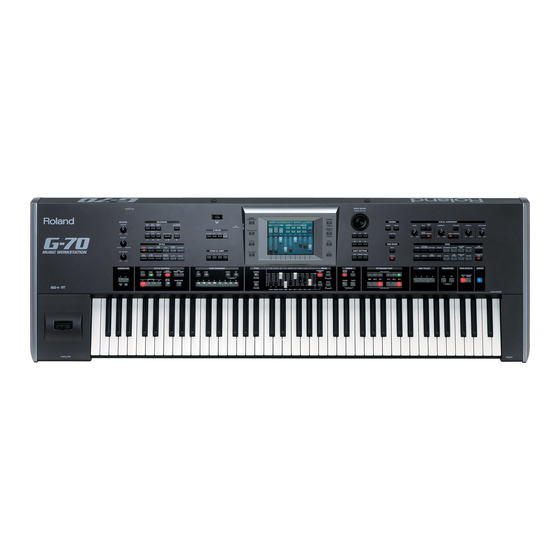
Roland G-70 Addendum
Os version 2
Hide thumbs
Also See for G-70:
- Owner's manual (261 pages) ,
- Service notes (89 pages) ,
- Specifications (4 pages)
Table of Contents
Advertisement
Quick Links
Advertisement
Table of Contents

Subscribe to Our Youtube Channel
Summary of Contents for Roland G-70
- Page 1 Addendum English •...
-
Page 2: Table Of Contents
Your G-70 provides a Guitar mode that allows you to Leaving the G-70’s Guitar mode ......5 play extremely realistic guitar parts via the keyboard. -
Page 3: First Steps
The notes you play in the “CHORD” area are not [EXIT] button, the display changes: played by the G-70’s Guitar section. They only specify what you will hear when you… (4) Press the first “C” key to the right of the “CHORD”... -
Page 4: Leaving The G-70'S Guitar Mode
“window” that shows you how the chords you play on the keyboard are Leaving the G-70’s Guitar mode transformed into guitar chords. The To leave the Guitar mode, press any EASY SETTING small numbers refer to the lowest fret ([ARR], [ORGAN] or [PIANO]) or KBD MODE button being used. -
Page 5: Playing Question And Answer Phrases
G e Down fast mute 4/a up fast 4 (Eb6)—Again 4 sim- Guitar mode is active, so that the chords you play with your left hand are used both by the G-70’s Arranger and its Guitar mode ulated strings that are strummed in two directions. The functionality. -
Page 6: Guitar Mode Options
G-70 Music Workstation OS Version 2 G HOLD PEDAL—This function only works if you connect Guitar Mode Options an optional DP-2, DP-6, or BOSS FS-5U footswitch to the There are additional functions you can set to fine-tune HOLD FOOTSWITCH socket. The pedal’s behavior depends your virtual guitar’s behavior. -
Page 7: Style Converter
G-70’s Arranger. should become Style tracks. Remember that a song • Your new Style resides in the G-70 Style RAM mem- may contain up to 16 tracks, while a Music Style ory. Do not forget to save it before selecting another “only”... -
Page 8: Auditioning The Tracks
Style data already present in start playback. This mutes all other tracks, while the the G-70’s Style RAM area. If you need to start from selected track is flagged with an “S”. scratch, however (to create an entirely new Style)…... - Page 9 C chord in the chord recognition area, the G-70 uses the original notes of the pattern (no realtime transposition). If that pattern is in F# and if you forgot to tell the G-70 that it is, F# is what you will hear when you play a C or C chord.
-
Page 10: Recording Harmonist And Guitar Parts
G-70 Music Workstation OS Version 2 If the selected memory area already contains a Music Recording Harmonist and Guitar Style of that name, you are asked whether it is OK to parts (16-track Sequencer) overwrite it. Several new functions have been added to the 16-track... -
Page 11: Melody Intelligence
1~3 GS (cannot be changed) Melody Intelligence This function has become more flexible: GS (cannot be changed) Selecting a Harmony Type also means that the G-70 GS*, automatically assigns a suitable sound to the 7~10 GS (cannot be changed) MELODY INTELL part (e.g. a trumpet and sax sounds... -
Page 12: Linking Melody Intell Type Selection To The Styles (Style Melody Intell Link)
Note: All MELODY INTELL settings can be written to a User Program and recalled at a later stage. (3) Press the [STYLE¥MELODY¥INTELL¥LINK] field to switch it off. If it is on, the G-70 assigns a suitable MELODY INTELLIGENCE type to each Style you select. -
Page 13: Using The Style Cover Function
G-70 Music Workstation OS Version 2 Using the Style Cover function Editing song data using Microscope Edit A new field has been added to most pages that has the following function: IGraphic representation of your data (piano roll) To get a better idea of where your data are located and how they are distributed, press the field. -
Page 14: Song And Style Makeup Tools
(but you don’t have to) “commit” your changes, thereby turning them into “regular” song or Style data. (MAKEUP TOOLS settings are SysEx data only the G-70 understands.) This may come in handy for two reasons: •... -
Page 15: Recording Styles From Scratch
OS Version 2 Recording Styles from scratch Editing individual Style events (Style Micro Edit) The G-70’s Guitar mode also allows you to record guitar parts for your Music Styles: General notes about STYLE MICRO EDIT IGraphic representation of your data (piano roll) -
Page 16: Other Edit Operations
G-70 Music Workstation OS Version 2 Other edit operations Disk/Media functions ICREATE EVENT Press this button icon to add a new event to the Copying User Program sets to floppy disk selected track. The following pop-up appears: It is now also possible to copy User Program sets to floppy disk (in addition to the internal memory and a memory card). -
Page 17: Midi
G-70 Music Workstation OS Version 2 MIDI Miscellaneous The transmit and receive channels of the Keyboard Measure indication in the display parts are set as follows: When you press the [INTRO] button… Keyboard part Recorder track The Arranger plays the introduction of the currently selected Music Style. -
Page 18: Accessing The 'Patches' Of Srx-Series Expansion Boards Via Midi
G-70 Music Workstation OS Version 2 Accessing the ‘Patches’ of SRX-series expansion boards via MIDI Drum Sets of the SRX-series expansion board use the CC00 value “92”. The CC32 value to use can be found in the documentation that came with the expansion board you installed. - Page 19 R® 602000129 RES 474-05 Printed in Italy 07-05 G-70 – Addendum Ver. 2.0 E/F/D...














Need help?
Do you have a question about the G-70 and is the answer not in the manual?
Questions and answers